ISSN 2348-3156 (Print)
International Journal of Social Science and Humanities Research ISSN 2348-3164 (online)
Vol. 10, Issue 3, pp: (327-340), Month: July - September 2022, Available at: www.researchpublish.com

ISSN 2348-3156 (Print)
International Journal of Social Science and Humanities Research ISSN 2348-3164 (online)
Vol. 10, Issue 3, pp: (327-340), Month: July - September 2022, Available at: www.researchpublish.com
1Joseph David Madasi, 2Christopher Manjeka, 3Akwer Eva
1 College of Mathematics and Computer Science, Zhejiang Normal University, 688 Yingbin, Ave, Jinhua 321004, China
2Christopher Research Firm, Dar es Salaam, Tanzania
3College of Mathematics and Computer Science, Zhejiang Normal University, 688 Yingbin, Ave, Jinhua 321004, China
DOI: https://doi.org/10.5281/zenodo.7016651
Published Date: 23-August-2022
Abstract: This paper investigates the short-term impact of the coronavirus (COVID-19) outbreak on the banking system tipping points in all affected countries across the globe. The consequences of infectious disease are considerable and have directly affected the banking system worldwide. Using the Lotka-Volterra complex system theory approach, this study develops the complex dynamical model for investigating the role of the pandemic towards the banking system tipping points. Our results indicate that the banking system in major affected economic zones fell quickly during the critical virus outbreak. The Eurozone experienced more negative abnormal returns during the crisis than other economic zones. Further results confirmed that the promotion of the banking system zscore improves the tipping point locations to large values and thus, enhances an exponential growth of the banking system. Moreover, the study of banking systems can be applied as an optimal control approach to reduce economic risks, increase banking sector performances, and avoid financial collapse.
Keywords: banking system resilience; tipping point; bank-cost; Lotka-Volterra theory; economic zone; system bifurcation
Many complex banking systems within the phase periods are at risk of an unexpected collapse or tipping to alternative states. Risk and unpredictable disruptions are inevitable facts of life for ecological and banking systems [1-3]. These disruptive economic shocks demand that the ecosystem resist or adapt for survival [4]. Subsequently, the concept of improving banking system resilience has emerged as a potential alternative to conventional risk management options as applied in other industrial ecosystems [5-8]. A vital component of any resilient banking system is the promotion of adaptive capabilities that allow the system to withstand economic cascading failures caused by bank costs [9] structurally. Although conventional risk management strategies significantly reduce the impacts of specific sources of shocks [10, 11], they cannot comprehensively cope with banking system dynamics and uncertainty. This study investigates the short-term effect of the COVID-19 outbreak on the banking system. The study is carried out and achieved by using the three-phase period (before, during the crisis, and recovery) data. The rationale behind using such data is to investigate how the financial perturbation affected the bifurcations (tipping points) by shifting their locations towards the undesirable regime. Moreover, the results of this study will suggest an optimal risk mitigation strategy as an adaptive capability [12-14]
Banking system resilience is broadly defined as the capability of a system to absorb financial shocks and reorganize while changing to retain the same function, structure, identity, and feedback [15-17]. The concept of banking system resilience
ISSN 2348-3156 (Print)
International Journal of Social Science and Humanities Research ISSN 2348-3164 (online)
Vol. 10, Issue 3, pp: (327-340), Month: July - September 2022, Available at: www.researchpublish.com
embraces the fact that every production system will always be subject to unprecedented cascading failures. From the perspective of the banking system, scholars defined banking system resilience as an ecosystem that has developed adaptive capabilities after having experienced unexpected economic shocks [17]. System resilience, a theory originating from socioecological studies investigated by Huang, and Shi [18], is the ability of a system to withstand any shocks structurally, predicted, or unpredicted. From this perspective, banking producers have implemented banking resilience techniques into their risk management strategies for many years. Yet, in terms of reasonable risk management practices like the suggested optimal strategy, applications of system resilience in the banking sector are still evolving [19, 20]. Survival in the turmoil of the COVID-19 outbreak, banking sectors need to improve their processes, systems, and technologies to be dynamic and flexible and meet the ongoing changes in the global market [21]. Nowadays, economic perturbations lead to a high banking system risk of uncertainty. If these financial shocks become real, they can negatively impact the banking system resulting in deformed. Many studies have shown that modern banking systems are at greater risk than their managers recognize [22, 23]
Investigating and analyzing the influence of the COVID-19 pandemic on the tipping point locations of the banking system is essential in strategically locating critical facilities as network operations strategies [2, 24-26]. In support of this, we introduce the adopted Lotka-Volterra complex system approach [27-29] to analytically examine the underlying varying bank-cost tipping point locations that unveil the banking system resilience during the COVID-19 pandemic. The approach investigates the variation in the bank-cost tipping point locations for different economic zones (continent-based). The tipping point variation identifies the zone system's robustness against initial loss and the rapidity of the recovery process In this study, we discuss the background of the COVID-19 outbreak and the tipping point as introduced by [30, 31]. We then definepredicted bankingsystembehaviorasan analyticmeasureandprovideasimpleapproachtoimprovethebanking sector's resilience. The resilience value depends on the behavioral patterns of the banking system z-score.
The COVID-19 pandemic caused the most dramatic financial crashes in history. The crash was triggered by the virus that originated in Wuhan, China. Initially, it was not believed that this virus could be lethal and propagate to every part of the world. The novel COVID-19 pandemic crisis has shaped an extraordinary situation for our generation, with many nations being on lockdown. This new situation comes with many psychological encounters not only for health care workers and peoplesufferingfromCOVID-19butalsoforthebankingsystemdynamics[32].Adaptingtothenewsituation,assuggested by Ashraf [12], Ma [14] can be demanding to avoid the global economic shocks, and the corresponding collapses. Recent researchers have argued that emotions during this situation are very similar to grief [33]. People experience a financial decline in the normal banking services lives in the banking system, which can even jeopardize the exponential growth of other sectors like the fishing industry [2].
There is growing concern over tipping points arising in banking systems because of facing disruptive events. Specifically, atinydisturbanceinaninputconditionresultinginhuge,sudden,andoftenirreversiblechangesintheregimeofadynamical system is known as "tipping" or "critical transition" [30, 34, 35]. Tipping points lead to abrupt and possibly irreversible shifts between alternative banking system regimes, potentially incurring high bank-cost. The banking system z-score is central to the banking cost feedbacks that regulate the bank-cost spikes, as they govern the responses of price volatility to banking system resilience that could withstand the financial shocks. However, we know little about how the COVID-19 pandemic affects the occurrence of tipping points and even less about how big-scale banking system resilience shifts reciprocally related to system dynamics. We argue that the connection between the banking system z-score and bank cost should be taken into account to understand the balance of feedback governing tipping points in banking systems. Moreover, the banking system is governed by the developed model that encompasses the bipartite mutualistic interaction the banking sectors. The banking sector's interaction which is governed by the coefficient of interaction strength ij plays a vital role on improving the banking system resilience by enhancing the tipping point locations to high values and improving the exponential growth of the banking sectors.
ISSN 2348-3156 (Print)
International Journal of Social Science and Humanities Research ISSN 2348-3164 (online) Vol. 10, Issue 3, pp: (327-340), Month: July - September 2022, Available at: www.researchpublish.com
Key: P1-P20 is the 20 banks
Source: Author concept visualization plot
Simulation tool: GEPHI
Figure 1: Graphical representation of the seller-buyer bipartite stock market network
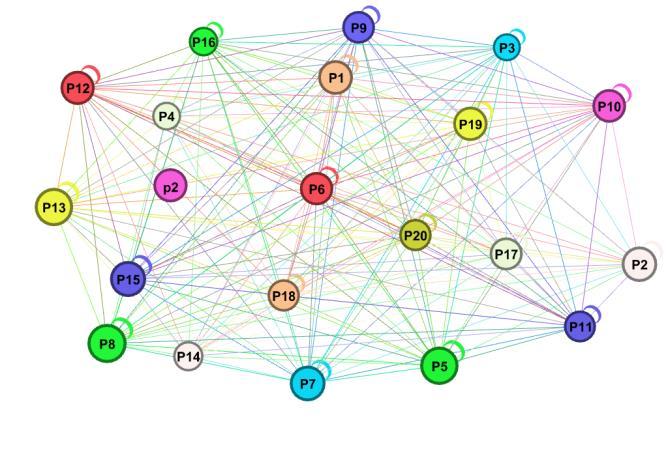
This study contributes to the literature on whether the COVID-19 crisis drives the decline inbanking tippingpoint locations. The contribution is explored twofold. First, applying the adopted Lotka-Volterra system model of the banking system dynamics context introduces the banking system resilience perspective to current risk management literature in this field. Second, the empirical outcomes provide valuable insights into risk mitigation strategies in the face of increasing bank costs and tipping points drop caused by the COVID-19 pandemic and the Ukraine-Russia war.
The remainder of this paper is arranged as follows. The following parts portray the related literature review and knowledge gaps. Section three develops the banking system model using the adopted Lotka-Volterra model system. This section also explains the data and economic regions (zones) under study. Section four presents and discusses the simulation outcomes. The final section concludes the research and suggests future recommendations in banking and other financial sectors.
Recently, the impacts of the COVID-19 pandemic on the banking system have been broadly studied by recent scholars [32, 36, 37]. The studies associated, in fact, how banking systems affected by the pandemic outbreak challenges as the ability of the latter systems not to return to a state of equilibrium after a temporary disruption [23, 37]. In connection to the education system point of view, scholars have argued that the COVID-19 pandemic is a huge challenge to education systems [38]. To curb the challenge, scholars in recent studies further suggested asynchronous learning as an adaptive capability tool. The rapid spread of COVID-19 across the created subsequent fear and finally triggered the halt of various economic activities [39]. The banking system responses to the pandemic crisis have differed markedly depending on the nation's culture [40, 41]. Using Ordinary Least Square (OLS) regression approach, Herwany, et al. [42] aimed to confirm if the COVID-19 pandemic has had a significant effect on existing sectors and how that shakes the Indonesian Stock Exchange (IDX) market returns. Judging from the aggregate value of abnormal returns, the results showed that stock markets on the Indonesia Stock Exchange (IDX) were affected by the COVID-19 pandemic. By investigating the effect of the rapid spread of COVID-19 on financial markets, Zhang, et al. [31] used quantitative easing (QE) approach to confirm that, the pandemic has created an unprecedented level of risk, causing stock investors to suffer significant loses in a very short period of time. Recently, the scholars examined the banking system response to the COVID-19 pandemic in Europe. In the analysis, the scholars found that, banking collapse was strong during early days of confirmed cases [43]. Overall, their results suggested that stock markets quickly responded to COVID-19 pandemic and this response varies over time depending on the degree of outbreak. In a perspective of the US and Canada, the recent studies confirmed that, the COVID-19 pandemic has dragged down the economy at both global and country-specific levels since the beginning of 2020. Using a structural VAR model, which is adopted to accommodate GARCH-in-mean errors, the scholars further unveiled an unexpected increase in the COVID-19 cases to hurt the stock return with persistence in Canada [44]
ISSN 2348-3156 (Print)
International Journal of Social Science and Humanities Research ISSN 2348-3164 (online)
Vol. 10, Issue 3, pp: (327-340), Month: July - September 2022, Available at: www.researchpublish.com
Our study aims to extend the concept of tipping points in banking systems. This is a regime shift where turning back the direction of change will not immediately restore the level of banking system services. In recent studies, scholars have been carrying out the analysis of tipping points of ecosystems to mitigate the risks. Farazmand [13] examined the capability of linear delay feedback control to minimize these tipping points, ensuring that the systems stay near a desirable regime. Tipping points exist in ecological, social, and environmental systems, which are increasingly causally intertwined in the anthropocene [34]. The study of Tàbara, et al. [35] introduced the notion of positive tipping points as emergent properties ofsystemsthatwouldallowthefastdeploymentofevolutionary-liketransformativesolutionstosolvethepresentecosystem challenges successfully. Their research revealed how to identify the required capacities, conditions, and potential policy interventions which could eventually lead to the development of positive tipping points in various social–ecological ecosystems. The study of tipping points has been broadly examined in diversified disciplines. In social perspective, Bentley, et al. [33] investigated the Social dynamics system behavior and argued that, social tipping points are particularly difficult to predict. Tipping points in complex systems are structural transitions from one state to another. In banking systems, these critical points are connected to systemic risks, which have steered to the financial crisis in the past [37, 45]. Gualdi, et al. [46] proposed the possible types of phenomena that simple macroeconomic Agent-Based models (ABMs) can reproduce. By presenting a methodology inspired by statistical physics that characterizes a model through its phase diagram in the space of parameter values, they found that there is a generic existence of tipping points between robust economic strength where unemployment is a low and bad economy where unemployment is high.
This paper is the first to investigate how the COVID-19 pandemic can impact the banking system configurations towards the low state shifts using the Lotka-Volterra complex theory approach. First, our adopted Lotka-Volterra model system incorporates the banking system z-score, which dampens the bank cost towards the tipping points. Second, it empirically unveils the critical transitions (points to which the banking system bifurcates) from the desirable regime to the undesirable regime and from which managers, scientists, and regulators can strategically optimize the banking systems to a resilient regime. Third, we introduce the coefficient of banking mutualistic interaction strength. This makes the argument robust and innovative in that all the banking sectors in the system are getting benefited symmetrically. Finally, we reduce the formulated multi-dimensional complex model to get a one-dimensional, feasible system for an effective simulation. The combination of all these steps makes the study novelty and innovative.
This study adopts the general theory of the Lotka-Volterra complex systems approach [47]. This method highlights systems' nonlinear, networked, adaptive, and emergent behavior [48]. Therefore, we developed a new banking system model based on the Lotka-Volterra complex system approach and reduced it from multiple dimensions to one-dimension. The rationale behind system model reduction is to improve the efficiency and reliability of empirical outcomes [49, 50]. The stepwise derivation of the banking complex model from formulation to analysis is provided in Appendix B.
Let
x
be the growth rate of the banking network at node i with time t, assuming that one banking sector has business connections with the other banking sectors. The bank sectors are the nodes in the networks, and banking transactions correspond to edges, as shown in Figure 1. The highest possible banking sector growth rate (0)iiKK with an intrinsic revenue growth rate constant (0)ii
, as per the logistic model system for this sector, is as follows:
The revenue growth rate ix of bank sector i can also be affected by the bank-cost i . Here, we apply population dynamics and organizational ecology concepts to adopt and investigate dynamic systems and system resilience variation. This computation can be achieved by adopting the bank cost as a harvesting effort parameter and introducing it into Equation (1) to obtain the harvesting effort model [51]. The equation becomes:
ISSN 2348-3156 (Print)
International Journal of Social Science and Humanities Research ISSN 2348-3164 (online) Vol. 10, Issue 3, pp: (327-340), Month: July - September 2022, Available at: www.researchpublish.com
The functioning of the entire banking sector is determined by the system configuration (topology structure) in which the banking sectors are connected. The configuration of the system is weighted using the connectivity matrix that captures mutualistic interactions between nodes (banking sectors) [52, 53]. The concept in Figure 1 exhibits how banking sectors (nodes) are connected to form a system configuration matrix 0 ijA of the sector connections. Thus, Equation (2) can be further developed by incorporating the mutualistic interaction term to obtain:
++ (4) where iD , iE and j H are parameters that characterize the saturation rate of the response function () iji i iiijj
x gx DExHx = ++ (5) Promoting the banking system's z-score can also enhance the exponential growth is [23, 45, 55]. We adopted the model system by adding the banking system z-score parameter to the banking system resilience function (,) iifs . This can be achieved by incorporating the term i into the governing parameter coefficient of the banking system z-score. Thus, the developed model becomes: 1 1 N ijij ii iiiiii iiiijj j
xx dxx xxx dtKDExHx =
dxxx dtKxxx Dhx =+−−+ + (7)
=+−−+ ++ (6) In Appendix B, we detail the steps of our dimension-reduction procedure, which leads to the reduced model. ( ) 2 1 effeffeff effeffeffeffeffeff eff effeffeff
The first term of the right hand side of the Equation (7) accounts for the resilience of the banking network at a rate effeff x . The second term describes the effective logistic growth of the banking system with an effective maximum potential capacity effK and the effective banking resilience, according to which for weak resilience ( 0 effx ) the banking system features negative growth. The third term describes the banking system collapse at a rate effeff x and fourth term unveils banking sectors' mutualistic interaction, captured by a response function that saturates for large ix and j x , indicating that ' j s positive contribution to ix is bounded. To construct the estimated which is an effective interaction coefficient, we used the adopted symbiotic interaction relationship [3], collected for financial returns of all banking sectors, describing networks ranging from 1Nn = to 2Nn = nodes where 12nn and 12 , nn
We numerically solved Equation (7) and tested its resilience under realistic bank-cost spikes perturbation caused by the COVID-19 crisis (Figure 2a and 2b): first, we took the curated data results of the three-year period (2018-2019, 2019-2020 and 2019-2021. The rationale behind choosing the range of time is to obtain the three distinct features (before, during the crisis, and recovery) of the banking system's dynamic behavior at a steady state when the system was perturbed to collapse. Finally, using MATHEMATICA and MATLAB mathematical tools, we set eff , effK , , effD and effh to examine the impact of bank cost triggered by the COVID-19 outbreak on banking system resilience in the three phase-period.
ISSN 2348-3156 (Print)
International Journal of Social Science and Humanities Research ISSN 2348-3164 (online) Vol. 10, Issue 3, pp: (327-340), Month: July - September 2022, Available at: www.researchpublish.com
The data structure investigates the role of the COVID-19 outbreak on the resilience of banking sector systems. To calibrate the developed model, we took the information of banking sectors of all countries across the globe and relied on transaction data sources. In this study, we obtained the banking system z-score and bank-cost data from 2018 to 2020 (before, during the crisis and recovery), sourced from the global economy database (https://theglobaleconomy.com/). The selected data involve the 2019-2020 COVID-19 outbreak crises, making the study robust. Moreover, all selected member countries collectively comprised more than the threshold sample size
Using the software mathematical tools we ran banking resilience function (Equation (7)) on the increasing bank-cost in threeconsecutiveyears(2018-2019,2019-2020and2020-2021)toinvestigatetheimpactofCOVID-19towardsthebanking system resilience (banking sector growth). Results reveal the impact of banking z-score towards the banking system growth. At 0 effx , the system collapses when the bank cost rises. On the other hand, the banking system loses stability to the point of no return c as shown in Figure 2a. This dynamic critical transition in which the banking system bifurcates (deviates) from a stable state (thick blue line) to an unstable state (red line) is called a tipping point P (Figure 2a, 2b) [30]. This is the point beyond which, the system experiences the no-return collapse (the banking system collapses completely).
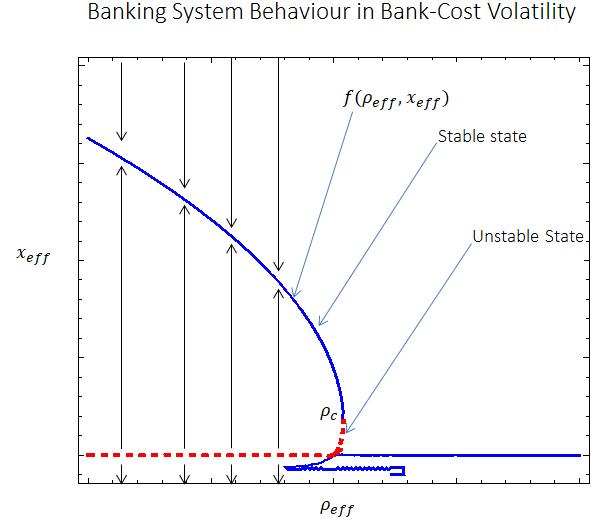
(a)
(b)
Figure 2: (a) The bifurcating function that shows the critical transitions of the banking system
(b) The tipping point location of the banking system
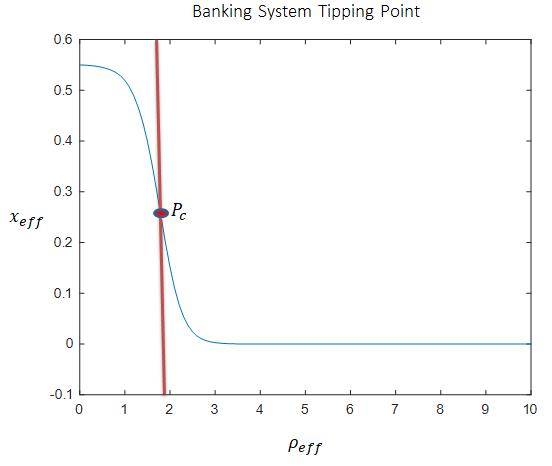
ISSN 2348-3156 (Print)
International Journal of Social Science and Humanities Research ISSN 2348-3164 (online) Vol. 10, Issue 3, pp: (327-340), Month: July - September 2022, Available at: www.researchpublish.com
The results in Figure 3a and 3b unveil the dynamic system behavior based on the empirical outcomes. In all the banking systems, the results show that, first, when 0 effx , the banking system experiences two states (stable hx at 0 eff
f x and unstable at 0 eff
f x ).
Furthermore, the results reveal that, in all systems, the increase of bank cost enhances the collapse towards the tipping point. The location of the tipping point (Figure 3b) (at the intersection between the shaded area and the blue line) was varying with the period and banking system of different amount of FDI. This indicates that each banking system experiences different location in tipping point. Second, when 0 effx = , all banking systems were at zero stable state where the system is neither growing nor collapsing. Despite experiencing the stable state, the banking system was less resilient because of the lowest degree of the system growth rate (i.e. 0 effx = ). Finally, when 0 effx , the tested empirical results were unrealistic and thus, no conclusion drawn. Moreover, the empirical outcomes of banking system are discussed in threephase period (before, during the crisis and during recovery).
4.1 Before the COVID-19 outbreak (2018-2019)
This was the period in which no one could predict the economic cascading failures. In this period, the banking system was resilient with high values of banking z-score. On the other hand, the banking cost was not volatile (less bank-cost) at an extreme value and thus, the tipping points were located at optimal values. The banking z-score much influenced this bifurcation point (tipping point) locations. The empirical results further reveal that during this period, the global economic zone experienced the highest tipping point location of bank cost with 11.49% c = followed by the China zone with 10.15% c = . The Eurozone was the economic region with the smallest value of tipping point location with 4.83% c =
In this period, the results confirm that the US economic zone was the most resilient zone followed by the China zone. The Eurozone was the least resilient banking system in that, for the US zone to collapse completely, it needs to reach the bankcost of 11.49% c = while the Eurozone collapses completely (tipping point) at 4.83% c = . Additionally, all economic zones, including the global economy, experience the moderate values of banking system z-score as summarized in Table A1 (Appendix A) and data-based bank-costs which were not exceeding the thresholds, indicating the optimal banking system performance.
4.2
This was a time phase in which the outbreak started to prevail. The results confirm that during the COVID-19 crisis in 20192020, the global banking system experienced the rise of bank cost except for China while their tipping point locations went into well controlled except for China that dropped to 9.95% c = (summarize in Appendix Table A2). This indicates that the banking systems were improving despite the COVID-19 crisis except for China that affected by the outbreak (i.e. decreasing its bank-cost threshold value to which the system tips). The results further unveil the US to experience the enormous value of threshold bank-cost of 12.82% c = during the crisis. This implies that, the US was the zone that experienced the most resilient economic region.
4.3
This period was when vaccination and other risk mitigation measures were carried out to curb the shock. In this phase there were some economic zones started to recover (China zone) and others went into critical shocks. The results show that, there was an improvement of banking system performance for the China zone in a sense that all economic zones dropped in tipping point locations except for China which improved from 9.95% c = to 11.22% c = . Here we see that, European
ISSN 2348-3156 (Print)
International Journal of Social Science and Humanities Research ISSN 2348-3164 (online) Vol. 10, Issue 3, pp: (327-340), Month: July - September 2022, Available at: www.researchpublish.com
zone showed the largest critical transition drop from 6.17% c = (2019-2020) to 4.60% c = (2020-2021) equivalent to 23.18% drop, followed by the Global zone with a decline from 12.82% c = (2019-2020) to 11.22% c = (20202021) which was equivalent to 12.48% This economic improvement also occurred to China which experienced the lowest value of bank cost with 0.3052 eff = . On the other hand, the system was collapsing during the critical global crisis in a view that, all the economic zones were still experiencing the rise in bank cost eff except for the China (2020-2021) economic zone that managed to control the cost from eff = 0.3117 (2019-2020) to eff = 0.3052 (2020-2021)
(a) (b)
Figure 3: (a) The critical transitions of the banking system based on the empirical outcomes.
(b) The tipping point locations of the banking system based on the empirical outcomes. The results (Figure 4a-4g) show that the banking system z-score enhances the banking sector performance by lowering the bank-cost degree and improving theexponentialgrowthof thefunctionofthebankingsystem. This implies that, thebanking system becomes more resilient at lower bank costs than at higher bank-cost. The simulation results further confirm that, all economic zones including the global economy were experiencing more optimal banking system performance when the bank-cost degree was small. In all three phases, the empirical outcomes revealed that the banking system z-score values were affected much by the COVID-19 outbreak. The results confirmed this by unveiling the drop of z-scores during the critical global crisis. The decline occurred for all economic zones as exhibited in Figure 4(a-d).
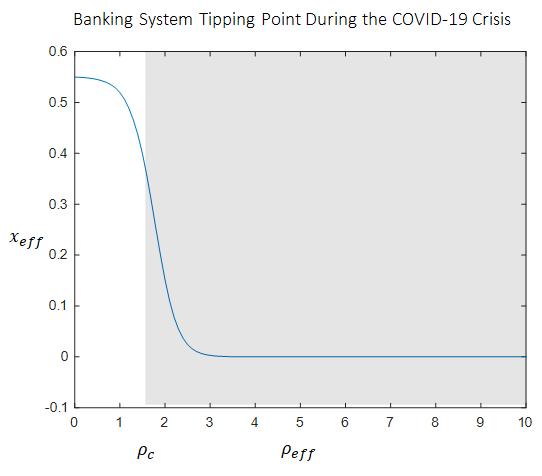
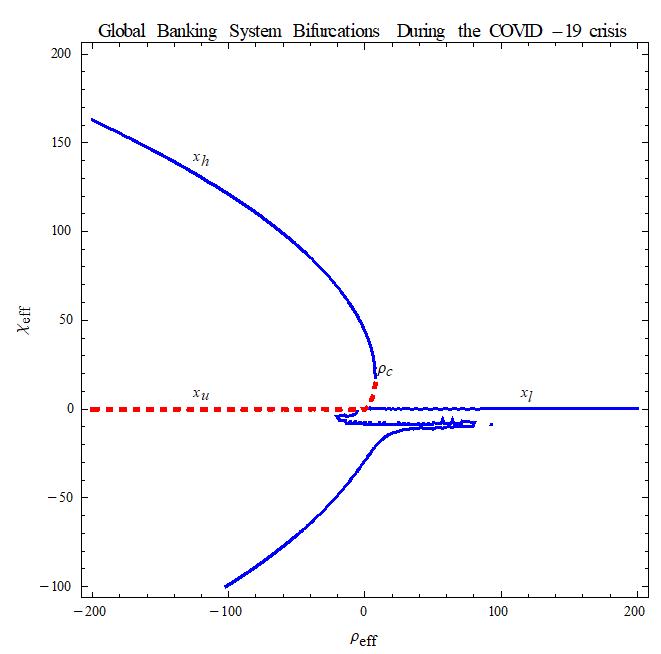
ISSN 2348-3156 (Print)
International Journal of Social Science and Humanities Research ISSN 2348-3164 (online) Vol. 10, Issue 3, pp: (327-340), Month: July - September 2022, Available at: www.researchpublish.com
Furthermore, Global economic zone showed a tremendous rise in z-scorein theperiod 2019-2020that promoting thegrowth of system resilience (Figure 4a). Figure 4b reveals that Eurozone experienced chaotic behavior in all three phases of the pandemic and gives an early warning for the risk mitigation measures to be taken within a short period before the total banking system collapse occurs. Figure 4c and 4d show the banking system resilience of China and the US, respectively. The resultsconfirmthat despite the cascading failures triggered by the COVID-19 outbreak,China and theUS were resilient enough to withstand the financial perturbations.
(a) (b) (c)
ISSN 2348-3156 (Print)
International Journal of Social Science and Humanities Research ISSN 2348-3164 (online) Vol. 10, Issue 3, pp: (327-340), Month: July - September 2022, Available at: www.researchpublish.com
(d)
Figure 4 (a-d): The effect of banking z score on the banking system resilience in the three phase-periods (20182019, 2019-2020 and 2020-2021) for four economic Zone.
There is a significant impact of the COVID-19 outbreak crisis on the banking system's tipping point location (point of total collapse). This is to say that; COVID-19 is considered an economic perturbation that jeopardizes the banking system performance by reducing its tipping point locations and dampening the exponential growth of the performance. This work proposes a theoretical framework for investigating the role of COVID-19 towards the tipping points by revealing the threephase variation of the location in threshold values of the bank cost at which the system bifurcates. Our developed banking complexdynamicmodelisbased ontheLotka-Volterrasystemtheory.Thismethodologicalapproachbridgesthetheoretical gap by investigating the variation of the bank-cost parameter when the system is subjected to the COVID-19 crisis using the Lotka-Volterra complex system theory. In many recent studies, scholars discussed the Lotka-Volterra ecosystem model on the ecology of plant-pollinator and prey-predator relationships [27, 29, 56, 57]. Brodie, et al. [58] pointed out the effect of COVID-19 on the complex system performance (resilience) using an approach based on a review of the service ecosystem, but all these studies could not appeal to the application of Lotka-Volterra theory in recent banking system crises. Applying the Lotka-Volterra system model theory to investigate the point to which the banking system bifurcates gives the study novelty. The results unveiled that the system is more likely to crash when bifurcates at low tipping point locations. Moreover, we confirm that the banking system becomes more robust at a large value of the banking z-score. The small degree of z-score exerts a tremendous negative impact on the tipping point location by lowering its bank-cost threshold value, thereby triggering the banking system collapse. Our study contributes for economic regulators, managers, and in policymaking decisions. First, from an ex-ante perspective, policy makers, economic managers and regulators can promote the performance of the banking system by controlling the degree of the bank-cost rise and the tipping point locations. This improvement can be achieved by promoting the value of the banking z-score as carried out by China during the critical crisis of 2019-2020 in which improved from 22.89% = to 24.11% = while all of the zones were collapsing during the critical turmoil (2020-2021).
This outcome will make the banking system robust and focused on withstanding the economic collapse caused by the COVID-19 outbreak crisis. This work contributes an intuitive and straightforward way to identify the bank cost degree that can push the banking system towards tipping points collapse. Thus, regulators and policymakers can recommend an appropriate strategy as a system control method. We hope that our adopted Lotka-Volterra system model approach will influence the interest of future economic researchers from diverse disciplines. The theory approach includes investigating the influence of the bank cost and banking system z-score on the system resilience. It thus provides chance for future researchers to have a deeper insight into financial and other global economies.
ISSN 2348-3156 (Print)
International Journal of Social Science and Humanities Research ISSN 2348-3164 (online) Vol. 10, Issue 3, pp: (327-340), Month: July - September 2022, Available at: www.researchpublish.com
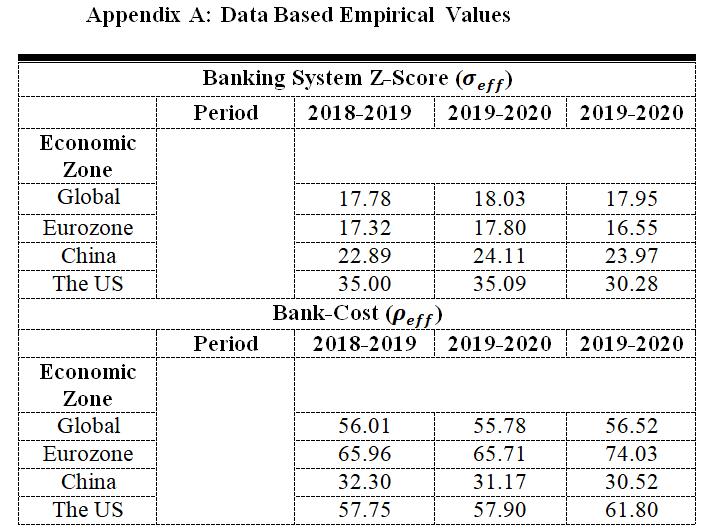
Source: Author computation
Table A1: Average banking system z-score and bank-cost for four Economic Zones from 2018-2021
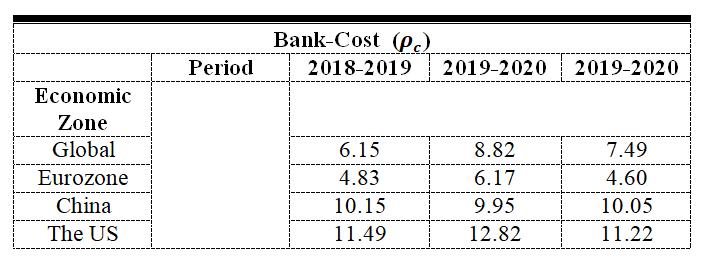
Source: MATHEMATICA Simulation
Table A2: Threshold values of bank-cost for four economic zones from 2018-2021
Appendix B
•
Taking Equation (7), our derivation process is based on the assumption that the carrying capacity iK for all banking sectors 1,2... in = has an identical value: ieffKK which is similar to, ieffDD and ij . The basic idea of dimension reduction is to feature the banking network's configurations by determining an effective dynamical parameter [59, 60] This calculation can be achieved by having an approximate manipulation as iieffeff xx , iieffeff xx , iieffeff xx and iieffeffhxhx where effx is the effective growth rate of the banking sector. Combining all these reduced terms, the Equation (6) becomes an effective Equation (7).
Funding: This research received no external funding
Author Contributions: Conceptualization, methodology, software, Christopher Manjeka.; validation, Christopher Manjeka formal analysis, Christopher Manjeka investigation, Christopher Manjeka resources, Christopher Manjeka.; data creation, Christopher Manjeka.; writing original draft preparation, Christopher Manjeka.; writing review and editing, Joseph David Madasi; visualization, Christopher Manjeka.; supervision, Christopher Manjeka; project administration, Christopher Manjeka
Data Availability Statement: All data outcomes used in this paper extracted from the global economy database (https://globaleconomy.org/).
Conflicts of interest: The authors declare no conflict of interest.
ISSN 2348-3156 (Print)
International Journal of Social Science and Humanities Research ISSN 2348-3164 (online) Vol. 10, Issue 3, pp: (327-340), Month: July - September 2022, Available at: www.researchpublish.com
[1] G. S. Cumming and G. D. Peterson, "Unifying research on social–ecological resilience and collapse," Trends in ecology & evolution, vol. 32, pp. 695-713, 2017.
[2] S. Kiyama and S. Yamazaki, "The impact of stock collapse on small-scale fishers' behavior: evidence from Japan," Canadian Journal of Fisheries and Aquatic Sciences, vol. 75, pp. 2241-2254, 2018.
[3] S. Pettersson, V. M. Savage, and M. Nilsson Jacobi, "Predicting collapse of complex ecological systems: quantifying the stability–complexity continuum," Journal of the Royal Society Interface, vol. 17, p. 20190391, 2020.
[4] V. C. Westmont, "Assessing the adaptive resilience of twentieth-century post-industrial fishing landscapes in Siglufjörður, Iceland," Landscape Research, vol. 46, pp. 693-712, 2021.
[5] N. C. Dormady, A. Rose, A. Roa-Henriquez, and C. B. Morin, "The cost-effectiveness of economic resilience," International Journal of Production Economics, vol. 244, p. 108371, 2022.
[6] S. Duchek, "Organizational resilience: a capability-based conceptualization," Business Research, vol. 13, pp. 215-246, 2020.
[7] R. J. Floetgen, J. Strauss, J. Weking, A. Hein, F. Urmetzer, M. Böhm, et al., "Introducing platform ecosystem resilience: leveraging mobility platforms and their ecosystems for the new normal during COVID-19," European Journal of Information Systems, vol. 30, pp. 304-321, 2021.
[8] S. M. Grabner and M. Modica, "Industrial resilience, regional diversification and related variety during times of crisis in the US urban–rural context," Regional Studies, pp. 1-13, 2021.
[9] P. H. Kupiec and C. D. Ramirez, "Bank failures and the cost of systemic risk: Evidence from 1900 to 1930," Journal of Financial Intermediation, vol. 22, pp. 285-307, 2013/07/01/ 2013.
[10] T. Saeed, E. Bouri, and D. K. Tran, "Hedging strategies of green assets against dirty energy assets," Energies, vol. 13, p. 3141, 2020.
[11] X. Sun, C. Liu, J. Wang, and J. Li, "Assessing the extreme risk spillovers of international commodities on maritime markets: a GARCH-Copula-CoVaR approach," International Review of Financial Analysis, vol. 68, p. 101453, 2020.
[12] B. N. Ashraf, "Stock markets' reaction to COVID-19: Moderating role of national culture," Finance Research Letters, vol. 41, p. 101857, 2021.
[13] M. Farazmand, "Mitigation of tipping point transitions by time-delay feedback control," Chaos: An Interdisciplinary Journal of Nonlinear Science, vol. 30, p. 013149, 2020.
[14] H. Ma, "Adaptive investment approach," Available at SSRN 2359011, 2013.
[15] S. Hosseini, K. Barker, and J. E. Ramirez-Marquez, "A review of definitions and measures of system resilience," Reliability Engineering & System Safety, vol. 145, pp. 47-61, 2016/01/01/ 2016.
[16] C. Ruza, M. de la Cuesta-González, and J. Paredes-Gazquez, "Banking system resilience: an empirical appraisal," Journal of Economic Studies, 2019.
[17] F. Vallascas and K. Keasey, "Bank resilience to systemic shocks and the stability of banking systems: Small is beautiful," Journal of International Money and Finance, vol. 31, pp. 1745-1776, 2012/10/01/ 2012.
[18] Y. Huang, W. Shi, C. Wei, and S. Zhang, "A stochastic predator–prey model with Holling II increasing function in the predator," Journal of Biological Dynamics, vol. 15, pp. 1-18, 2021.
[19] A. Capponi and P.-C. Chen, "Systemic risk mitigation in financial networks," Journal of Economic Dynamics and Control, vol. 58, pp. 152-166, 2015/09/01/ 2015.
[20] P. Harle, A. Havas, and H. Samandari, "The future of bank risk management," McKinsey Global Institute2016.
[21] O. Khlystova, Y. Kalyuzhnova, and M. Belitski, "The impact of the COVID-19 pandemic on the creative industries: A literature review and future research agenda," Journal of Business Research, vol. 139, pp. 1192-1210, 2022.
ISSN 2348-3156 (Print)
International Journal of Social Science and Humanities Research ISSN 2348-3164 (online) Vol. 10, Issue 3, pp: (327-340), Month: July - September 2022, Available at: www.researchpublish.com
[22] A. Demirgüç-Kunt and E. Detragiache, "The determinants of banking crises in developing and developed countries," Staff Papers, vol. 45, pp. 81-109, 1998.
[23] X. Li, D. W. Tripe, and C. B. Malone, "Measuring bank risk: An exploration of z-score," Available at SSRN 2823946, 2017.
[24] H. Liu, A. Manzoor, C. Wang, L. Zhang, and Z. Manzoor, "The COVID-19 outbreak and affected countries stock markets response," International Journal of Environmental Research and Public Health, vol. 17, p. 2800, 2020.
[25] M. Topcu and O. S. Gulal, "The impact of COVID-19 on emerging stock markets," Finance Research Letters, vol. 36, p. 101691, 2020.
[26] F. Zeren and A. Hizarci, "The impact of COVID-19 coronavirus on stock markets: evidence from selected countries," Muhasebe ve Finans İncelemeleri Dergisi, vol. 3, pp. 78-84, 2020.
[27] O. Malcai, O. Biham, P. Richmond, and S. Solomon, "Theoretical analysis and simulations of the generalized LotkaVolterra model," Physical Review E, vol. 66, p. 031102, 2002.
[28] X. Mao, S. Sabanis, and E. Renshaw, "Asymptotic behaviour of the stochastic Lotka–Volterra model," Journal of Mathematical Analysis and Applications, vol. 287, pp. 141-156, 2003.
[29] L. Wu, S. Liu, and Y. Wang, "Grey Lotka–Volterra model and its application," Technological Forecasting and Social Change, vol. 79, pp. 1720-1730, 2012.
[30] A. de Zeeuw and C.-Z. Li, "The economics of tipping points," vol. 65, ed: Springer, 2016, pp. 513-517.
[31] D. Zhang, M. Hu, and Q. Ji, "Financial markets under the global pandemic of COVID-19," Finance research letters, vol. 36, p. 101528, 2020.
[32] I. Aldasoro, I. Fender, B. Hardy, and N. A. Tarashev, "Effects of Covid-19 on the Banking Sector: The Market's Assessment," 2020.
[33] R. Bentley, E. Maddison, P. Ranner, J. Bissell, C. Caiado, P. Bhatanacharoen, et al., "Social tipping points and earth systems dynamics. Frontiers in Environmental Science 2: 1–7," ed, 2014.
[34] T. M. Lenton, "Tipping positive change," Philosophical Transactions of the Royal Society B, vol. 375, p. 20190123, 2020.
[35] J. D. Tàbara, N. Frantzeskaki, K. Hölscher, S. Pedde, K. Kok, F. Lamperti, et al., "Positive tipping points in a rapidly warming world," Current Opinion in Environmental Sustainability, vol. 31, pp. 120-129, 2018.
[36] P. Bobade and A. Alex, "Study The Effect of Covid-19 in Indian Banking Sector," JournalNX, pp. 179-184, 2020.
[37] N. Borri and G. d. Giorgio, "Systemic risk and the COVID challenge in the european banking sector," Journal of Banking & Finance, vol. 140, p. 106073, 2022/07/01/ 2022.
[38] S. J. Daniel, "Education and the COVID-19 pandemic," Prospects, vol. 49, pp. 91-96, 2020.
[39] I. R. Ganie, T. A. Wani, and M. P. Yadav, "Impact of COVID-19 Outbreak on the Stock Market: An Evidence from Select Economies," Business Perspectives and Research, p. 22785337211073635, 2022.
[40] A. V. Thakor, "Corporate culture in banking," Available at SSRN 2565514, 2015.
[41] C. Bussoli, "Influence of national culture on bank risk-taking in the European system," in Risk Culture in Banking, ed: Springer, 2017, pp. 215-239.
[42] A. Herwany, E. Febrian, M. Anwar, and A. Gunardi, "The influence of the COVID-19 pandemic on stock market returns in Indonesia stock exchange," The Journal of Asian Finance, Economics and Business, vol. 8, pp. 39-47, 2021.
[43] P. Nathanial and L. Van der Heyden, "EU Banking in the COVID-19 Crisis: Time for a'New Deal'," 2020.
[44] L. Xu, "Stock Return and the COVID-19 pandemic: Evidence from Canada and the US," Finance Research Letters, vol. 38, p. 101872, 2021.
ISSN 2348-3156 (Print)
International Journal of Social Science and Humanities Research ISSN 2348-3164 (online) Vol. 10, Issue 3, pp: (327-340), Month: July - September 2022, Available at: www.researchpublish.com
[45] X. Li, D. Tripe, C. Malone, and D. Smith, "Measuring systemic risk contribution: The leave-one-out z-score method," Finance Research Letters, vol. 36, p. 101316, 2020/10/01/ 2020.
[46] S. Gualdi, M. Tarzia, F. Zamponi, and J.-P. Bouchaud, "Tipping points in macroeconomic agent-based models," Journal of Economic Dynamics and Control, vol. 50, pp. 29-61, 2015.
[47] S. Janzwood and J. Piereder, Complex Systems Approaches to Global Politics: Oxford University Press, 2020.
[48] F. Bento, M. Tagliabue, and I. Sandaker, "Complex systems and social behavior: Bridging social networks and behavior analysis," in Behavior science perspectives on culture and community, ed: Springer, 2020, pp. 67-91.
[49] N. M. Crout, D. Tarsitano, and A. T. Wood, "Is my model too complex? Evaluating model formulation using model reduction," Environmental Modelling & Software, vol. 24, pp. 1-7, 2009.
[50] M. Ilak, S. Bagheri, L. Brandt, C. W. Rowley, and D. S. Henningson, "Model reduction of the nonlinear complex Ginzburg–Landau equation," SIAM Journal on Applied Dynamical Systems, vol. 9, pp. 1284-1302, 2010.
[51] A. Singh and P. Malik, "Bifurcations in a modified Leslie–Gower predator–prey discrete model with Michaelis–Menten prey harvesting," Journal of Applied Mathematics and Computing, vol. 67, pp. 143-174, 2021.
[52] M. Agha Mohammad Ali Kermani, R. Ghesmati, and M. S. Pishvaee, "A robust optimization model for influence maximization in social networks with heterogeneous nodes," Computational Social Networks, vol. 8, pp. 1-17, 2021.
[53] X.-Q. Sun, H.-W. Shen, and X.-Q. Cheng, "Trading network predicts stock price," Scientific reports, vol. 4, pp. 1-6, 2014.
[54] G. T. Skalski and J. F. Gilliam, "Functional responses with predator interference: viable alternatives to the Holling type II model," Ecology, vol. 82, pp. 3083-3092, 2001.
[55] R. Pradhan, "Z Score Estimation for Indian Banking Sector."
[56] A. Elsadany and A. Matouk, "Dynamical behaviors of fractional-order Lotka–Volterra predator–prey model and its discretization," Journal of Applied Mathematics and Computing, vol. 49, pp. 269-283, 2015.
[57] J. M. Soberon and C. M. Del Rio, "The dynamics of a plant-pollinator interaction," Journal of Theoretical Biology, vol. 91, pp. 363-378, 1981.
[58] R. J. Brodie, K. R. Ranjan, M.-l. Verreynne, Y. Jiang, and J. Previte, "Coronavirus crisis and health care: learning from a service ecosystem perspective," Journal of Service Theory and Practice, 2021.
[59] M. Boss, H. Elsinger, M. Summer, and S. Thurner 4, "Network topology of the interbank market," Quantitative finance, vol. 4, pp. 677-684, 2004.
[60] C. Gola and A. Roselli, "The Configuration of the Banking System in the Last 15 Years," Palgrave Macmillan Studies in Banking and Financial Institutions, pp. 57-79, 2009.